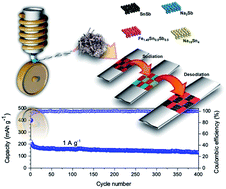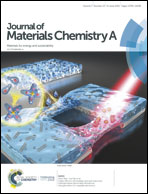Microstructurally engineered nanocrystalline Fe–Sn–Sb anodes: towards stable high energy density sodium-ion batteries†
Abstract
To facilitate the commercialization of sodium-ion batteries (SIBs), advanced electrode materials with high sodiation capacities and enhanced cycling stabilities are essential. Herein, we investigate the effect of Fe incorporation into SnSb to generate a new ternary nanocrystalline composite based anode, which improves the cycling stability and performance of SIBs. We ensure a high-throughput synthetic approach via a rapid-solidification technique for efficient and industrially viable Fe–Sn–Sb alloy synthesis. Interestingly, the new ternary system possesses nanocrystalline domains that helped to alleviate the stresses induced upon the sodiation/desodiation reactions and thereby enhanced the performance. The Fe1.0–SnSb anode delivered a capacity of ∼500 mA h g−1 at a specific current density of 50 mA g−1 for over 120 cycles and a full-cell was designed, which could deliver one of the highest reported energy densities of ∼826 W h kganode−1. The promising electrochemical results assert the significance of microstructural engineering of alloying anodes and open up new avenues of research into rapidly solidified alloys for energy storage applications.



 Please wait while we load your content...
Please wait while we load your content...